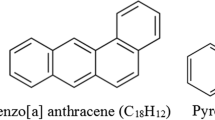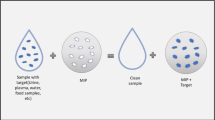Abstract
Molecular imprinting with binary mixtures of different polycyclic aromatic hydrocarbons (PAH) is a tool for design of chemically highly sensitive layers for detection of these analytes. Sensor responses increase by one order of magnitude compared with layers imprinted with one type of template. Detection limits, e.g. for pyrene, reach down to 30 ng L−1 in water, as could be observed with a naphthalene and pyrene-imprinted polyurethane. Comparing sensor characteristics obtained by QCM and fluorescence reveals different saturation behaviours indicating that, first, single PAH molecules occupy the interaction centres followed by gradual excimer incorporation at higher concentrations finally leading to substantial quenching, when all accessible cavities are occupied. The plateau in the mass-sensitive measurements suggests that up to 80% of the cavities generated in the MIP are re-occupied. Displacement measurements between chrysene and pyrene revealed that for imprinted layers with very high pyrene sensitivities the signals of both PAH are additive, whereas in materials with lower pyrene uptake the two analytes replace each other in the interaction sites of the polymer.







Similar content being viewed by others
References
Knopp D, Seifert M, Vaeaenaenen V, Niessner R (2000) Environ Sci Technol 34:2035–2041
Simko P (2002) J Chromatogr B 770:3–18
Moret S, Conte LS (2000) J Chromatogr A 822:245–253
Rodriguez JSS, Sanz CP (2000) Analysis 28:710–717
Barek J, Cvacka J, Muck A, Quaiserova V, Zima J (2001) Fresenius J Anal Chem 369:556–562
Schauer C, Niessner R, Poeschl U (2003) Environ Sci Technol 37:2861–2868
Fahnrich KA, Pravda M, Guilbault GG (2003) Biosens Bioelectron 18:73–82
Kirsch N, Hart JP, Bird DJ, Luxton RW, McCalley DV (2001) Analyst 126:1936–1941
Ferancova A, Korgova E, Labuda J, Zima J, Barek J (2002) Electroanalysis 14:1668–1673
Panne U, Knoller A, Kotzick R, Niessner R (2000) Fresenius J Anal Chem 366:408–414
Sluszny C, Gridin VV, Bulatov V, Schechter I (2004) Anal Chim Acta 522:145–152
Gobi VK, Miura N (2005) Sens Actuators B 103:265–271
Kurosawa S, Tawara-Kondo E, Minoura N, Kamo N (1997) Sens Actuators B 43:175–179
Stanley S, Percival CJ, Auer M, Braithwaite A, Newton MI, McHale G, Hayes W (2003) Anal Chem 75:1573–1577
Doong R, Shih H, Lee S (2005) Sens Actuators B 111/112:323–330
Wulff G (1995) Angew Chem Intl Ed Eng 34:1812–1832
Haupt K, Mosbach K (2000) Chem Rev 100:2495–2504
Hayden O, Lieberzeit PA, Dickert FL (2006) Adv Funct Mater 16:1269–1278
Hayden O, Mann KJ, Krassnig S, Dickert FL (2006) Angew Chem Int Ed 45:2626–2629
Dickert FL, Tortschanoff M, Bulst WE, Fischerauer G (1999) Anal Chem 71:4559–4563
Dickert FL, Achatz P, Halikias K (2001) Fresenius J Anal Chem 371:11–15
Dickert FL, Lieberzeit P, Tortschanoff M (2000) Sens Actuators B 65:186–189
Author information
Authors and Affiliations
Corresponding author
Additional information
Dedicated to Professor Wolfgang Lindner on the occasion of his 65th birthday.
Rights and permissions
About this article
Cite this article
Lieberzeit, P.A., Halikias, K., Afzal, A. et al. Polymers imprinted with PAH mixtures—comparing fluorescence and QCM sensors. Anal Bioanal Chem 392, 1405–1410 (2008). https://doi.org/10.1007/s00216-008-2413-1
Received:
Revised:
Accepted:
Published:
Issue Date:
DOI: https://doi.org/10.1007/s00216-008-2413-1




